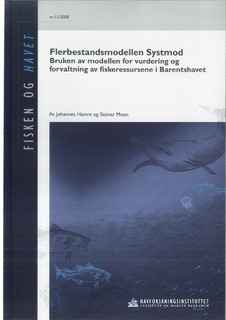| dc.description.abstract | The multi species model Systmod is a conceptual model, which gives a quantitative description of the production of biomass for the species capelin, herring and cod in the Barents Sea. Each of these species is modeled as conventional single specie models, where the specie interactions are related to the climate, and taken care of as mortality (predation) and food (growth) related to availability of prey. The model is coded and implemented by use of the dynamic simulation tool "Powersim'7 Studio 7", and the parameters are determined by tuning against relevant data from the period 1982 to 2005. The model simulates reasonably well the observed coherence between climate, fish stocks and catches in the actual period.
The capeliu is the most important feed for the cod. The most important specie interactions conceming the yield of cod is the influence of immature herring on the recruitment of capelin and the predation of cod of mature capelin and its own cod fry. Strong age groups of herring reduce the recruitment of capelin which reduce the growth of cod and delays the maturation of cod. Declining availability of capelin increases the cannibalism of cod, depending on the volume of recruits and the size of the older age groups of cod. These relations, in combination with climate variability and changes, are determinant for the dynamics of the system. The simulations indicate that optimal survival of legal catchable cod (above 3 years) are achieved by an equilibrium spawning stock of cod around 300 000 tons, corresponding to an instantaneous length hased mortaiity (F) of 0.6. For larger stocks, those are stocks with less mortality, cannibalism increase severely and reduce the recruitment to the legal catchable stock of cod. Optimal equilibrium yield is achieved for F = 0.8, which corresponds to an equilibrium spawning stock of just above 200 000 tons. This is in
accordance with ACFM's calculation of minimum acceptable spawning stock Blim of 220 000 tons corresponding to an age based Flim of 0,74. The results are also in accordance with historical data showing that the strongest year classes measured after 1950 is recmited from spawning stocks of around 200 000 tons. | en |
